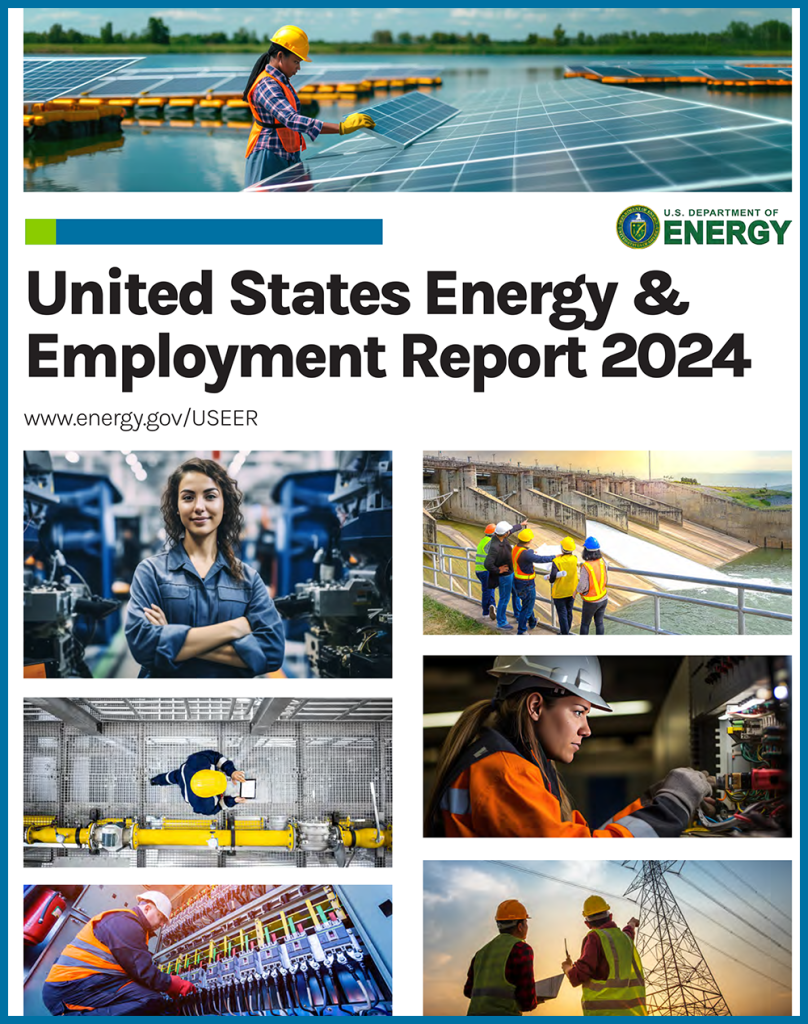Sep 9, 2024
Clean Energy Jobs Grew at More Than Twice the Rate of Overall U.S. Employment
The annual U.S. Energy and Employment Report (USEER) finds historic high unionization in the clean energy sector along with growth in clean energy jobs in every state.

Spurred by record investments in climate, clean energy, and manufacturing, U.S. clean energy employment increased by 142,000 jobs in 2023, accounting for more than half of new energy sector jobs and growing at a rate more than twice as large as that for the rest of the energy sector and the U.S. economy overall.
The U.S. Department of Energy (DOE) released the 2024 U.S. Energy and Employment Report (USEER), a comprehensive study designed to track and understand employment trends across the energy sector. As the private sector continues to announce major investments in American-made energy, the 2024 USEER shows that the energy workforce overall added over 250,000 jobs in 2023; 56% of those were in clean energy.
For the first time ever, unionization rates in clean energy, at 12.4%, surpassed the average rate in the energy sector of 11%, driven by rapid growth in unionized construction and utility industries. The sectors experiencing significant growth include zero-emission vehicle and renewable energy, as well as transmission, distribution, and storage – sectors crucial to achieving the Administration’s goal to reach 100% clean electricity by 2035 and delivering cheaper, more resilient energy to every community.
“Our policies are working. We are now starting to see the job impacts of investments made through the infrastructure and inflation reduction laws – first in construction, and as America builds more of these factories, we’ll see hundreds of thousands more,” said U.S. Secretary of Energy Jennifer M. Granholm. “The data clearly show that clean energy means jobs – good jobs, union jobs, and jobs retained – in communities across the country as we race to dominate the global clean energy economy.”
This year’s report reflects a record number of survey responses from 42,000 businesses nationwide.
Key Takeaways
- In 2023, clean energy was the driving factor for growth in the energy sector – jobs in clean energy grew by 4.2%, more than twice as much as the already robust job growth rate of 2.0% in the overall economy.
- Jobs in clean energy grew in all 50 states and the District of Columbia. In particular, Idaho had the fastest rate of clean energy job growth, increasing at 7.7%, followed by Texas at 6.0% and New Mexico at 5.9%.
- Both the solar and wind sectors reported strong job growth – jumping 5.3% and 4.5% respectively. Looking forward, DOE projects that the Inflation Reduction Act will double the share of electricity generation from clean sources by 2030, driven by growth in solar and wind. As the energy industry ramps up to meet this growth, construction is booming in many parts of the country. The energy construction sector added nearly 90,000 energy jobs, growing 4.5%, almost double the economy-wide construction employment growth of 2.3%.
- In addition to jobs in energy infrastructure like renewable energy and grid upgrades, jobs resulting from the construction of domestic clean energy manufacturing and supply chain facilities were tracked for the first time this year. In addition to the 90,000 traditional energy construction jobs, the report found an additional 28,000 jobs in 2023 carrying out the work of building new battery and solar module factories, ports for offshore wind, and warehouses to store and transport clean energy products.
Additional Highlights of the 2024 USEER include:
- From 2022 to 2023, employment increased across all five USEER energy technology categories: electric power generation, energy efficiency, fuels, motor vehicles, and transmission, distribution, and storage.
- The energy efficiency sector supported almost 2.3 million jobs in 2023, adding nearly 75,000 positions from the year before – the most of any sector. Energy efficiency includes the installation of several home energy improvements now eligible for tax breaks under the IRA, and the 3.4% growth rate was the strongest showing since 2018.
- Veterans account for 9% of the U.S. energy workforce, greater than their representation in the overall U.S. workforce. The energy workforce is younger than average, with 29% of workers below the age of 30.
- Latino and Hispanic workers held nearly one-third of the new energy jobs created in 2023, an increase of 79,000 workers.
- The energy industry sectors experiencing the highest job growth from 2022 to 2023 were utilities and construction.
- The utilities sector saw the fastest employment growth of 5.0% in 2023, adding nearly 30,000 jobs.
- The construction sector added nearly 90,000 energy jobs, growing 4.5%, almost double the economy-wide construction employment growth of 2.3%.
- Clean energy technologies accounted for 79% of net new electric power generation employment, adding 28,086 jobs. Wind and solar employment grew at rates well above average, and solar jobs became more demographically diverse and more heavily unionized.
- Motor vehicle jobs are growing, and the most rapid growth is in zero-emission vehicles. Nationwide, jobs in motor vehicles grew, with clean vehicle employment increasing 11.4%, adding 24,826 jobs.
State data show:
- Texas (969,801), California (932,273), Michigan (401,720), Florida (351,934), and Ohio (333,110) have the greatest number of energy jobs in the United States.
- California (545,207), Texas (261,934), New York (177,202), Florida (172,115), and Illinois (130,473) have the greatest number of clean energy jobs.
- Alabama (9.6%), Utah (7.8%), and North Carolina (6.9%) had the fastest rate of energy job growth from 2022 to 2023.
Methodology
The USEER began in 2016 to better track and understand employment within key energy sectors that have been difficult or impossible to follow using other publicly available data sources. The report is based on a customized energy employer survey that augments data from the Bureau of Labor Statistics to produce estimates of employment and workforce characteristics.
To learn more about the Department of Energy’s commitment to supporting high-quality energy jobs accessible to the diverse American workforce, visit DOE’s Office of Energy Jobs.
To read the full 2024 USEER National report, visit U.S. Energy & Employment Jobs Report (USEER).
This article was originally published by the US Department of Energy and is republished with permission.





